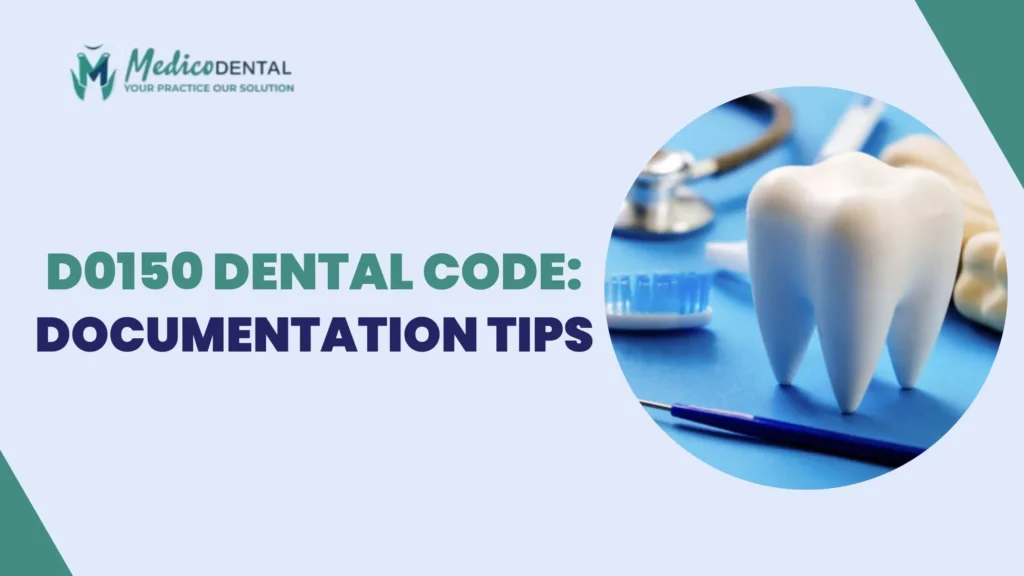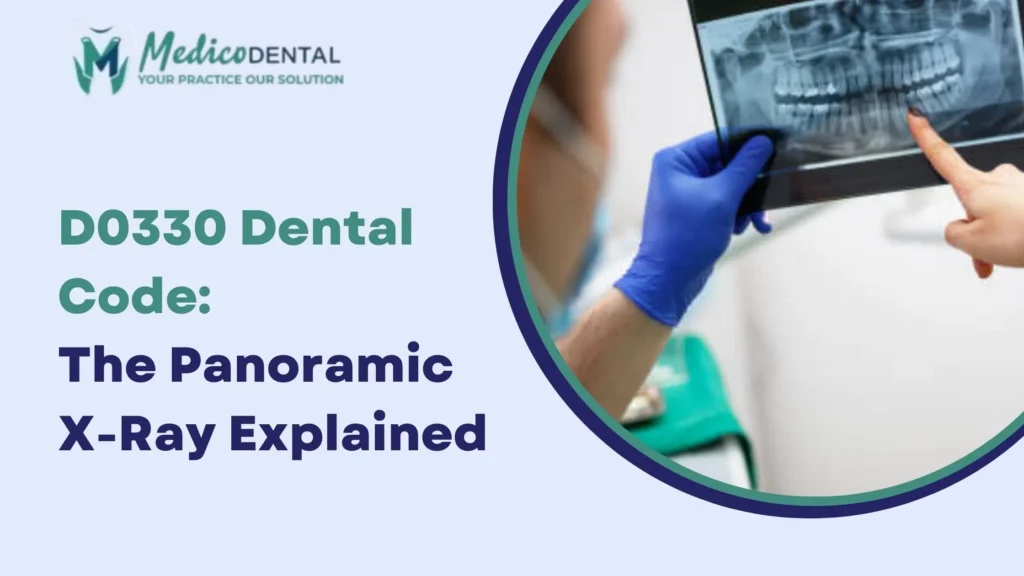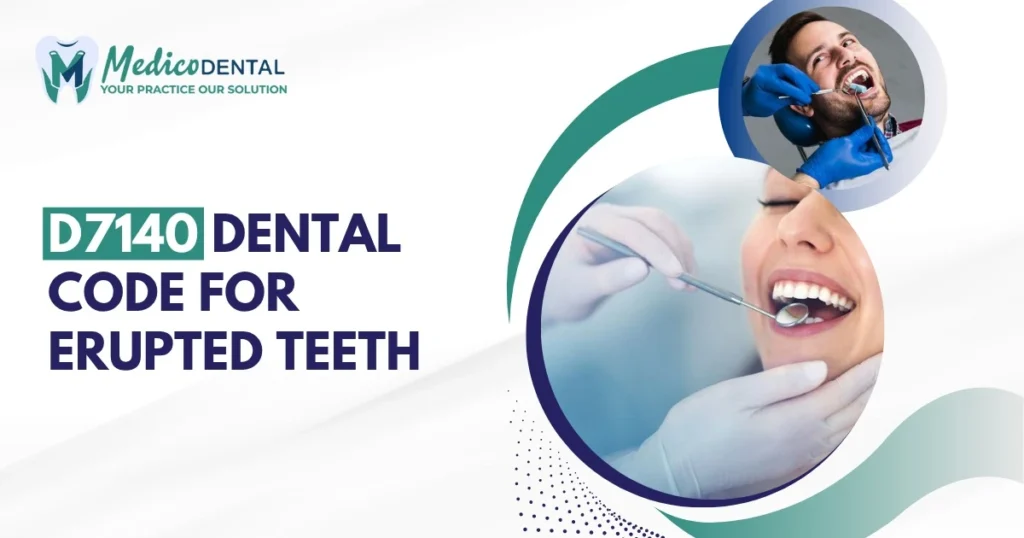A thorough understanding of D0150 Dental Code is essential for both dental professionals and billing teams. This CDT code represents the Comprehensive Oral Evaluation a complete assessment that establishes the foundation for a patient’s long term oral health plan. Whether you’re handling insurance claims or documenting patient visits, proper use of D0150 ensures accurate billing, compliance, and appropriate reimbursement.
What Is D0150 Dental Code ?
D0150 Dental Code refers to a Comprehensive Oral Evaluation New or Established Patient. It is used when a dentist performs an in depth assessment of a patient’s overall oral health, including a review of the medical and dental history, examination of teeth, gums, and soft tissues, and evaluation of the bite (occlusion).
This code is typically applied when a new patient visits the dental practice for the first time or when an existing patient requires a comprehensive reassessment.
Purpose of Using D0150
The main purpose of using D0150 is to establish a baseline for diagnosis and treatment planning. It allows the dentist to gather all essential information about the patient’s oral and medical condition.
This evaluation helps identify potential risk factors, underlying issues, and necessary preventive or restorative care. The comprehensive findings also guide future clinical decisions and ensure complete documentation for insurance purposes.
When to Use D0150 in Dental Billing
For New Patients
D0150 should be billed for new patients who are visiting the dental practice for the first time. During this visit, the dentist conducts a detailed review of the patient’s oral health, medical history, and risk factors. This initial exam sets the stage for all future treatment plans and records.
For Established Patients with Significant Changes
This code can also apply to established patients who have not been seen for three or more years or those who have experienced a significant change in health or medical history. For example, patients who have developed diabetes, undergone radiation therapy, or started new medications may require a full reassessment to ensure their dental care plan remains appropriate.
When Not to Use D0150
Do not use D0150 for routine checkups or limited exams. For instance:
- Routine recall visits should use D0120 (Periodic Oral Evaluation).
- Periodontal maintenance exams should be coded with D0180 if applicable.
D0150 represents a comprehensive and detailed assessment, not a standard checkup.
Components of a Comprehensive Oral Evaluation
Medical and Dental History Review
The evaluation begins with a thorough review of the patient’s medical and dental history, including any past treatments, medications, allergies, and systemic conditions. Understanding this background allows the dentist to identify factors that could impact oral health, such as diabetes or cardiovascular disease.
Oral Cancer Screening
As part of D0150, the dentist performs an oral cancer screening. This involves examining the lips, cheeks, tongue, and soft tissues for any abnormal lesions, discolorations, or growths. Early detection plays a crucial role in effective treatment and patient safety.
Periodontal and Soft Tissue Assessment
The dentist evaluates the gums and supporting structures, checking for inflammation, bleeding, or signs of periodontal disease. Pocket depths may be measured, and gum health is documented as part of the comprehensive evaluation.
Examination of Teeth and Occlusion
Each tooth is examined for decay, cracks, wear, restorations, and alignment. The dentist also assesses the occlusion (bite) to detect irregularities that may cause TMJ problems or uneven tooth wear. This step is vital for planning restorative or orthodontic care.
Documentation and Record Keeping
Accurate and detailed documentation is essential when billing D0150. Dentists should record all clinical findings, radiographs taken, risk assessments, and treatment recommendations. Clear documentation not only supports accurate coding but also protects the practice in case of an insurance audit.
D0150 vs Other Dental Exam Codes
D0120 Periodic Oral Evaluation
D0120 is used for established patients during routine checkups or recall visits. It’s less comprehensive and focuses on maintaining oral health rather than establishing a full diagnosis or treatment plan. This code applies when there are no major changes in the patient’s medical or dental condition.
D0180 Comprehensive Periodontal Evaluation
D0180 is specifically for patients with signs of periodontal disease or those who are under active periodontal treatment. It focuses on the gums, bone levels, and supporting structures rather than a full mouth evaluation.
How D0150 Differs from Other Exam Codes
Unlike D0120 and D0180, D0150 encompasses a full examination of all oral structures, including the teeth, soft tissues, and occlusion, while also incorporating medical and dental history review. It’s intended for establishing a comprehensive understanding of the patient’s oral health status, not for maintenance or limited focus areas.
Insurance Billing and Reimbursement for D0150
Common Payer Requirements
Insurance companies generally recognize D0150 as a billable code for new patient exams or established patients with significant changes. Most payers will not reimburse this code if billed too frequently, so it’s important to follow payer specific frequency limitations often once every three years for the same patient.
Documentation Tips for Clean Claims
To ensure timely reimbursement:
- Document all components of the exam clearly in the patient’s chart.
- Include clinical notes detailing medical history review, periodontal assessment, and diagnostic findings.
- Attach radiographs or intraoral images when required by the payer.
Thorough documentation demonstrates medical necessity and prevents claim rejections.
Avoiding Denials and Coding Errors
Common reasons for denial include using D0150 for a recall visit, failing to justify the comprehensive nature of the exam, or not including supporting documentation. Train administrative and clinical staff to understand when and how to use D0150 correctly, ensuring both compliance and proper reimbursement.
By understanding when and how to apply Dental Code D0150, dental professionals can improve claim accuracy, streamline reimbursement, and deliver better patient care. Proper use of this code not only supports clinical excellence but also strengthens the financial health of the practice.
Examples of D0150 in Practice
Understanding when and how to apply Dental Code D0150 becomes clearer with real world examples. These scenarios demonstrate how this comprehensive evaluation code is used in everyday dental practice and how proper documentation supports accurate billing.
New Patient Comprehensive Exam Example
A 34 year old patient visits a dental office for the first time, reporting mild sensitivity and requesting a full oral health evaluation. The dentist begins by reviewing the patient’s medical and dental history, including current medications and any past dental procedures.
A complete oral cancer screening is performed, followed by a periodontal assessment to check gum health and detect any inflammation. The dentist examines each tooth for decay, wear, or fractures and assesses the occlusion (bite) for irregularities.
Radiographs are taken to supplement the clinical findings, and all results are documented in the patient’s chart. The dentist then discusses a personalized treatment plan, which includes preventive care and recommendations for improved oral hygiene.
Because this visit represents the patient’s first comprehensive evaluation, the correct billing code is D0150 Comprehensive Oral Evaluation, New or Established Patient. The detailed documentation justifies the use of the code and supports reimbursement from the insurance payer.
Established Patient with Medical Change Example
An established patient who last visited three years ago returns for an appointment after being diagnosed with diabetes. The dentist determines that a comprehensive re evaluation is necessary to assess how the new medical condition may affect oral health.
During the exam, the dentist reviews the updated medical history, performs an oral cancer screening, and conducts a thorough periodontal assessment. Because diabetes can impact gum health and healing, additional diagnostic steps are taken to evaluate periodontal stability and potential risks.
All findings and changes in the patient’s health are recorded, and a new treatment plan is developed. Even though this patient is established, the D0150 code is appropriate due to the significant change in medical condition that warrants a comprehensive reassessment.
This example highlights that D0150 is not limited to new patients it also applies when major medical or dental changes require a full reevaluation.
Best Practices for Using D0150
Proper use of Dental Code D0150 ensures compliance with CDT coding standards and minimizes the risk of denials or claim delays. Following best practices helps your clinical and billing teams work more efficiently while maintaining accurate patient records.
Aligning Clinical Notes with CDT Definitions
To justify billing D0150, your clinical documentation must reflect the comprehensive nature of the exam as defined by the Current Dental Terminology (CDT) guidelines. The notes should clearly show that the dentist performed:
- A full medical and dental history review
- A complete examination of teeth, soft tissues, and occlusion
- Oral cancer and periodontal assessments
Include details on any diagnostic imaging, risk assessments, and the patient’s overall oral health status. Well documented notes demonstrate the medical necessity of the exam and support reimbursement during audits or insurance reviews.
Training Staff for Accurate Coding
Accurate coding begins with well trained staff. Both clinical and administrative teams should understand the differences between D0150, D0120, and D0180. Staff should know when to select each code and how to recognize qualifying conditions for a comprehensive evaluation.
Provide regular coding and documentation training to ensure your team stays current with CDT updates. Encourage communication between clinicians and billing specialists so that every exam is coded based on actual clinical findings, not assumptions or convenience.
Well informed staff help reduce claim denials, maintain compliance, and improve overall workflow efficiency in the dental practice.
Using D0150 with Other Related Codes
In some cases, D0150 may be used in conjunction with other CDT codes to fully describe the services rendered during a visit. For instance:
- Radiographs (D0210, D0274, etc.) may be billed when necessary for diagnosis.
- Diagnostic casts or photographs can also accompany the exam if they are clinically justified.
However, ensure that each code reflects a separate, distinct service and is supported by the clinical notes. Avoid “unbundling” or overcoding, as this can trigger insurance audits or claim rejections.
Proper integration of related codes ensures the practice receives full reimbursement for legitimate services while maintaining compliance with payer rules.
Key Takeaways on D0150 Coding and Usage
The D0150 Comprehensive Oral Evaluation is one of the most important CDT codes for dental professionals. It sets the stage for long term patient care and accurate recordkeeping. Understanding when and how to use it correctly ensures better outcomes for both the practice and the patient.
Key reminders:
- Use D0150 for new patients or established patients with major changes in medical or dental status.
- Avoid using D0150 for routine exams or recall visits those fall under D0120 or other codes.
- Document thoroughly to support the comprehensive nature of the evaluation.
- Train your staff to recognize when D0150 applies and how to code it correctly.
- Align with CDT guidelines and payer specific rules to prevent denials and delays.
When properly applied, D0150 not only ensures accurate billing but also reflects the high standard of care a practice provides. It captures the full picture of a patient’s oral and overall health making it a cornerstone of both clinical and administrative excellence in dentistry.
Conclusion
Understanding and correctly applying Dental Code D0150 is essential for maintaining both clinical accuracy and financial efficiency within a dental practice. This comprehensive oral evaluation forms the cornerstone of patient care providing dentists with the insights needed to create effective, long term treatment plans.
By documenting every element of the evaluation, from medical history to oral cancer screening, dental teams can ensure compliance, reduce claim rejections, and enhance patient trust. The distinction between D0150 and other exam codes such as D0120 or D0180 lies in its depth and diagnostic scope, making it vital for establishing a complete oral health baseline.
FAQs
What is Dental Code D0150 used for?
D0150 represents a Comprehensive Oral Evaluation for new or established patients. It’s used when the dentist performs a full oral assessment that includes reviewing medical and dental history, evaluating teeth and gums, checking the bite (occlusion), and screening for oral cancer. This code helps establish a complete baseline for diagnosis and treatment planning.
Who qualifies for a D0150 exam?
This code applies to:
- New patients visiting the practice for the first time.
- Established patients who have not been seen in over three years.
- Patients with significant medical or dental changes, such as a new diagnosis (e.g., diabetes), surgery, or medication changes that could impact oral health.
How often can D0150 be billed?
Most dental insurance carriers allow D0150 once every three years per patient per provider. However, policies may vary, so always check the payer’s frequency limitations before submitting claims to avoid denials.



